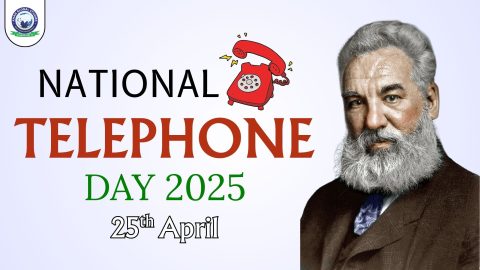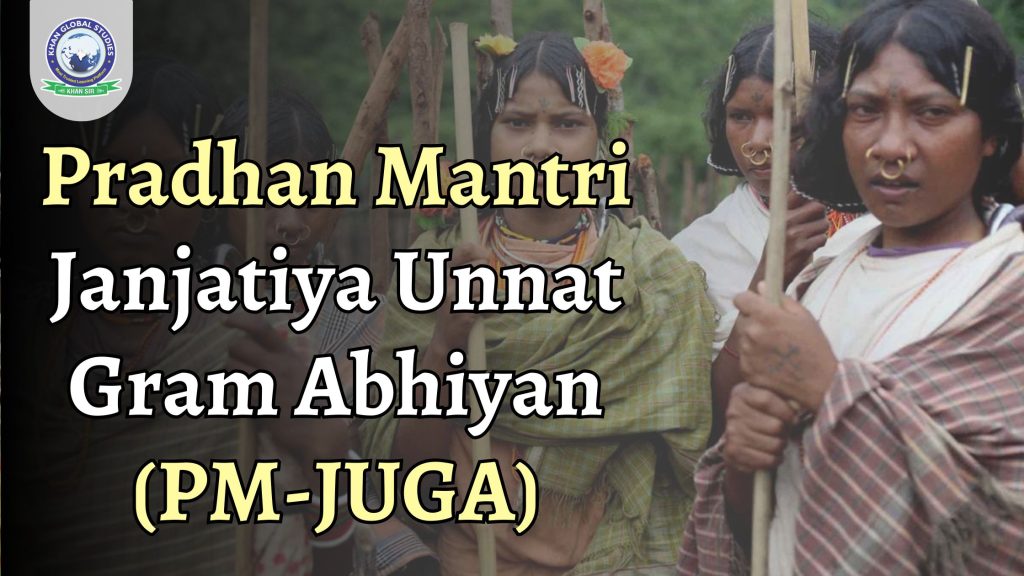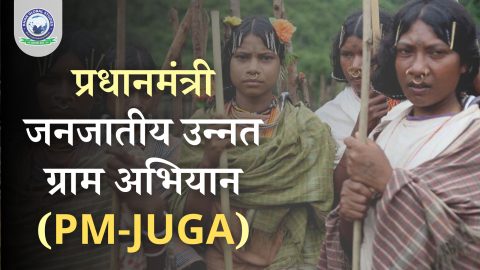Recently, the Union Cabinet gave the green signal to the Pradhan Mantri Janjatiya Unnat Gram Abhiyan (PM-JUGA), a transformational initiative designed to enhance the socio-economic fabric of tribal communities across India. This flagship programme seeks to uplift these often neglected communities by addressing deep-rooted challenges while promoting holistic development.
Key features of the Mission
The Union Cabinet made a massive allocation of ₹79,156 crore for PMJUGA over five years.
Objective: To uplift the socio-economic status of the tribal population through saturation of tribal-dominated villages and aspiring districts, ensuring that no family is left behind.
The mission aims to address critical gaps in infrastructure, healthcare services, education and livelihoods. It aims to implement a comprehensive strategy that integrates various government schemes to bring about sustainable change in these tribal areas.
Scope: The Mission has a very wide reach, covering 63,000 villages in 549 districts across 30 States and Union Territories and directly benefiting over 5 crore tribal individuals.
Tribal Population Snapshot
As per Census 2011, the Scheduled Tribe (ST) population in India is 10.45 crore, comprising over 700 distinct communities. Of these, 75 Particularly Vulnerable Tribal Groups (PVTGs) spread across 18 States and Andaman & Nicobar Islands have been given special focus under this initiative.
Implementation Strategy
With 25 tailored interventions across 17 Ministries, the Mission integrates government resources through the Development Action Plan for Scheduled Tribes (DAPST). The scheme builds on the successes and insights of the Pradhan Mantri Janshakti Awadhi Nyay Maha Abhiyan (PM-JanMahaan) with an emphasis on the transformation of tribal villages, which will be tracked on the PM Gati Shakti Portal. High-performing districts will be recognised and rewarded.
PM JANMAN Yojana
The Ministry of Tribal Affairs launched the PM-JANMAN initiative during Tribal Pride Day in November 2023. Targeting 75 PVTGs, it addresses gaps in healthcare, education, livelihoods and infrastructure for these vulnerable communities. With an outlay of ₹24,104 crore, it focuses on 11 interventions executed across 9 ministries.
Particularly Vulnerable Tribal Groups (PVTGs)
52 groups were identified in the PVTG category created in 1975 following the recommendations of the Dhebar Commission. By 1993, this number increased to 75. These groups, present in 18 states and the Andaman and Nicobar Islands, represent India’s most vulnerable tribes. Odisha alone is home to 13 of these groups.
Main Objectives of PMJUGA
- Comprehensive Development: PMJUGA aims to deal with all aspects of tribal development- education, health, infrastructure and economic empowerment.
- Empowerment: Providing the tribal population with the necessary resources to improve their quality of life and enhance their skills.
- Inclusion: Ensuring that tribal groups are integrated into mainstream society with equal opportunities.
- Sustainability: The mission promotes sustainable practices that protect the environment while promoting long-term development.
Key Components of PMJUGA
- Education: Providing scholarships, improving infrastructure and training teachers to enhance education in tribal areas.
- Healthcare: Establishing primary health centres and promoting preventive healthcare.
- Infrastructure: Building roads, and bridges and expanding electricity access to improve tribal connectivity.
- Agriculture and Livelihoods: Supporting sustainable farming, traditional crafts and vocational training.
- Social Justice: Addressing land and forest rights while ensuring gender equality for tribal communities.
Impact of PM Janjatiya Unnat Gram Abhiyan
- Standard of Living: Access to better education, healthcare and infrastructure has significantly improved lives in tribal areas.
- Empowerment: Tribals now have the tools to influence local governance and improve their economic status.
- Social Inclusion: The programme has promoted harmony while connecting tribal communities to mainstream society.
- Sustainable Development: The focus on equitable progress and environmental protection has ensured a balanced approach to development.
Mission Goals
- Infrastructure Expansion: Providing pucca houses, clean water, electricity and all-weather roads under Pradhan Mantri Awas Yojana and Jal Jeevan Mission. Additionally, ensuring internet and mobile connectivity in remote areas.
- Economic Upliftment: Promoting entrepreneurship through skill development programmes, creating marketing platforms and supporting tribal livelihood activities like agriculture and animal husbandry.
- Educational Access: Increasing enrollment rates to national standards by providing scholarships and building hostels for ST students.
- Healthcare Access: Improving tribal access to healthcare and meeting national health standards by providing mobile medical services in deprived areas.
Innovative schemes under PMJUGA
- Adivasi Habitatbhumi: Promoting 1000 Habitatbhumi under Swadesh Darshan, where each family will get Rs 5 lakh to build or renovate a Habitatbhumi, creating tourism-driven economic opportunities.
- Forest Rights for Livelihoods: Focusing on empowerment of 22 lakh FRA leaseholders, ensuring they benefit from forest rights.
- SCD Diagnostics: Affordable, accessible diagnostic services for sickle cell disease (SCD), with emphasis on prenatal diagnosis to prevent its spread.
- Tribal Multipurpose Marketing Centres (TMMCs): Establishment of 100 TMMCs to ensure tribal producers get a fair price for their produce and keep them away from middlemen.
Conclusion
The Pradhan Mantri Janjatiya Unnat Gram Abhiyan represents a significant shift in efforts to uplift India’s tribal population. By holistically addressing economic, social and educational challenges, the programme seeks to pave the way for sustainable development and empowerment for millions of tribal families. With an eye on inclusion, sustainability and growth, the initiative promises to integrate these communities into the broader fabric of Indian society, ensuring that they continue to thrive in the years to come.



